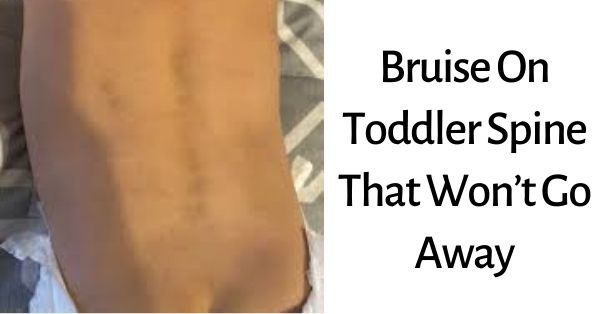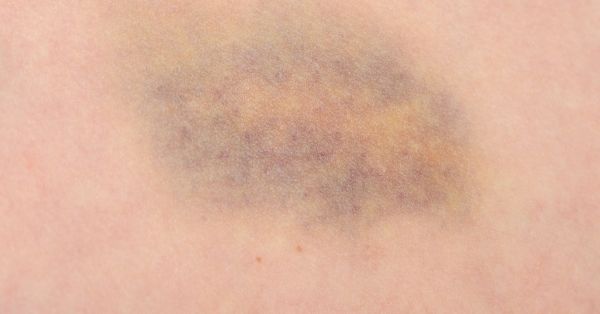While changing my 20-month-old nephew, I noted two blackish-brown bruises on his back. Going by his mother’s explanation, she started seeing them when he was 4 months old. I have seen bruises on my three babies but not on the spine.
Surprisingly, the bruises don’t seem to be changing, months later. I know about temporary bruises that heal within two weeks or so. But, what causes bruise on a toddler’s spine that won’t go away?
I have researched spine bruises in children, causes and signs that you should see a healthcare provider soonest possible.

Bruise On Toddler Spine That Won’t Go Away: Causes.
A bruise on your toddler’s spine may have several causes including falls/injuries, genetic bleeding disorder, child abuse, low platelet count, hemophilia and leukemia. Additionally, the bruise may be a harmless birthmark, a Mongolian spot, or a rare skin condition known as melanoma.
Normally, bruises are part of a healthy toddler’s growth life. In the process of learning and developing, they may easily bump their head or have a fall while making the first steps.
Most bruises fade away on their own. However, if it still lingers months later, your worry is justified. Any new or unusual development in your little one needs a doctor’s input.
Bruises On My Child’s Spine: What Could It Mean?
Toddlerhood is a stage full of endless falls, and injuries. It is normal to occasionally note bruises on your little one’s head, hands and leg. On the other hand, you’ll rarely see a bruise on your back or buttocks, and any of it may worry you.
Before you start panicking, let’s find out why bruises may develop on your toddler’s spine.
- Falls, bumps or injuries
As your toddler tries new things he’s likely to get a bruise once in a while. When trying to make the first steps, they may fall and get injuries.
Such bruises often result from the breakage of tiny blood vessels beneath the skin(capillaries). Mostly, the bruise heals naturally. Talk to your pediatrician about a seemingly permanent bruise.
- Genetic bleeding disorder(Von Willebrand Disease)
If blood doesn’t clot properly after trauma/injury, your child may get various bruises on the hurt area.
- Birthmarks may look like a bruise
Birthmarks can appear anywhere in your child’s body. They are noticeable at birth, may be permanent and easily confused with bruises.
- Melanoma
Though this skin condition worsens with age, toddlers too may develop this type of cancer. According to the American academy of dermatology association, between 200-300 children are diagnosed with melanoma every year in the U.S alone. Experts describe melanoma as a bruise-like dark spot that doesn’t go away.
- Child abuse
Normal bruising often happens in the hands and head. Bruises on the spine, buttocks, and neck could be a result of physical abuse. Since your little one may not communicate clearly, try to find out more about the possible abuse. When bruising happens at the same spot severally, it may not go away easily.
Are There Tests for the Bruise on My Toddler’s Back?
The thought of your little one having a medical condition could make you panicky. That’s why a test to confirm your fears is necessary. Some of the clinical tests for kids with strange bruises include:
- Peripheral blood smear
The quality of blood determines how it clots. The peripheral blood smear test is done on a child to determine blood level and quality. It shows why your child may be a habitual bruiser.
- CBC(Complete blood count)
This test shows the number of blood cells (red and white cells). Further, it screens the number of platelets in your toddler’s blood to detect its clotting ability.
- Fibrinogen test
Fibrinogen assists your blood to clot properly. A fibrinogen test seeks to gauge if the child has the right amount of fibrinogen necessary for preventing over bleeding and bruising.
- Bleeding duration/time
A child that bleeds longer is more likely to have bruises. To determine your child’s bleeding time after an injury, the paediatrician conducts this test.
- Platelets function screening (PFA-100)
This test seeks to establish the working condition of your child’s platelets. Dysfunctional platelets lead to abnormal blood clotting.
- Ristocetin/ Von Willebrand antigen test
These antigen tests detect Von Willebrand disease which often causes bleeding issues in children.
Once your doctor performs these tests, he’ll be in a better position to offer treatment –if necessary.
How Does A Suspicious Bruise On The Spine Look Like?
Not all bruises are life-threatening in toddlers. However, if you notice a bruise that’s itchy, has swelling around it and also keeps increasing in size/density, seek medical attention immediately.
Internal bruising is hard to see. You may watch out for signs of swelling and pain as a result of a deeper injury.
Is Bruising Preventable In Children?
No. Bruising is normal in any toddler’s life. While going through growth and development, they may get occasional bumping, falls or injuries that are unavoidable.
You may notice a swollen forehead or bruised hand. Talk to your doctor about any bruises on your toddler’s spine to avoid medical emergencies.
How Do I Tell That the Bruises on My Child’s Spine Aren’t A Sign Of Leukemia?
Leukaemia presents as red bruise-like spots on your toddler’s skin, it comes with other symptoms including fever, frequent nose bleeding and swollen lymph nodes.
Any bruises that have any other colour other than red may not be leukaemia. Also if you only notice bruises alone, it could be another different condition.
To be safe, ask your doctor about it.
When Is It Time To See A Doctor?
The spine is a delicate part of a human’s body. A Bruise that stays for months/ years should be checked by your physician.
- If the small bruise on a toddler’s spine isn’t a birthmark or Mongolian spot According to the Royal Children’s Hospital Melbourne, Congenital dermal melanocytosis (Mongolian spots) are most common at the base of the spine, on the buttocks, back and shoulders.
Any abnormal bruise on the spine that’s not a birthmark or Mongolian spot calls for your doctor’s attention.
- When the bruises grow in number or density
Bruises that increase in size could harm your child. Check them regularly to detect such traits early.
- If your child feels pain around the bruises
Normal bruises are mild, less painful and easy to manage using painkillers. Prolonged pain means there’s a serious underlying injury.
- When the bruise doesn’t heal or takes long to go away
Since they are growing, toddlers heal bruises naturally within 2 weeks. Visit your doctor if your child’s bruise won’t go away.
- If you notice prolonged bleeding
Bleeding from a bruise is a danger sign in need of medical attention. Your child may be having blood clotting issues.

Home Remedies For Bruise On Toddler Spine That Won’t Go Away
Before going to your doctor, you may try treating the bruises at home. Like any other bruises, they may go away with time. Sometimes, they may be permanent.
Some home remedies to try include:
- Cold compressing
If e bruise is bleeding, soak a clean cloth in cold water and hold over the affected area for ten minutes. You may also wrap an ice cube, frozen cabbage leaf or kale on a clean cloth and press it on the bruise. Cold pressing alleviates pain while preventing over-bleeding.
- Painkillers for infants
If the bruise is a result of a fall, bump or injury, it may be painful. Visit a pharmacist for advice on the most suitable pain management medication for your toddler. In the event the discomfort doesn’t subside, call your paediatrician.
- Offer moral support, love and care
Any discomfort on your baby’s body may be stressful. Show your munchkin love, care and support to calm him down and make him feel better.
While bruising is normal in healthy growing toddlers, exercise caution when treating them at home. Most will heal with time. If they take long or may be a cause of concern, seek medical help.
Wrapping Up
It’s enjoyable to see your baby make the first wobbly steps. It shows they are successfully achieving milestones. However, no one told you about the numerous falls and bumps you should expect.
Have you noticed a bruise on toddler spine that won’t go away? Don’t stress over it. The bruise may be a birthmark or Mongolian spots that show from birth.
Other underlying medical conditions like blood clotting disorders and melanoma (a rare skin cancer), may present like a bruise on your baby’s spine. Often, bruises could be a sign of leukaemia.
Normal bruising heals within a few weeks so, so any bruise that takes long to heal has bleeding and swellings, and may be dangerous. Some tips to improve the bruise include cold pressing and painkillers for alleviating pain.
Always visit your doctor to confirm if the bruise on your child’s spine is normal or not.
More to read: